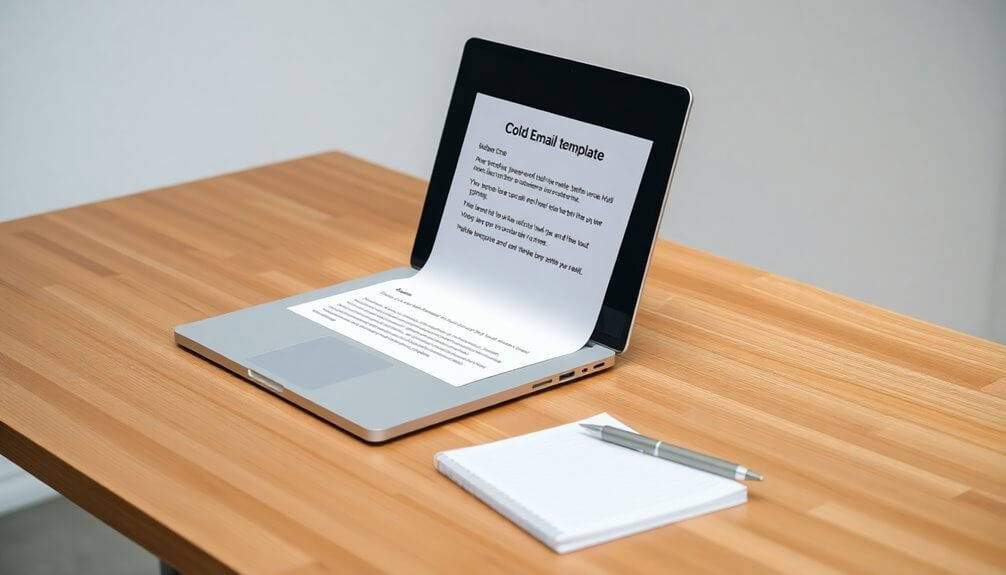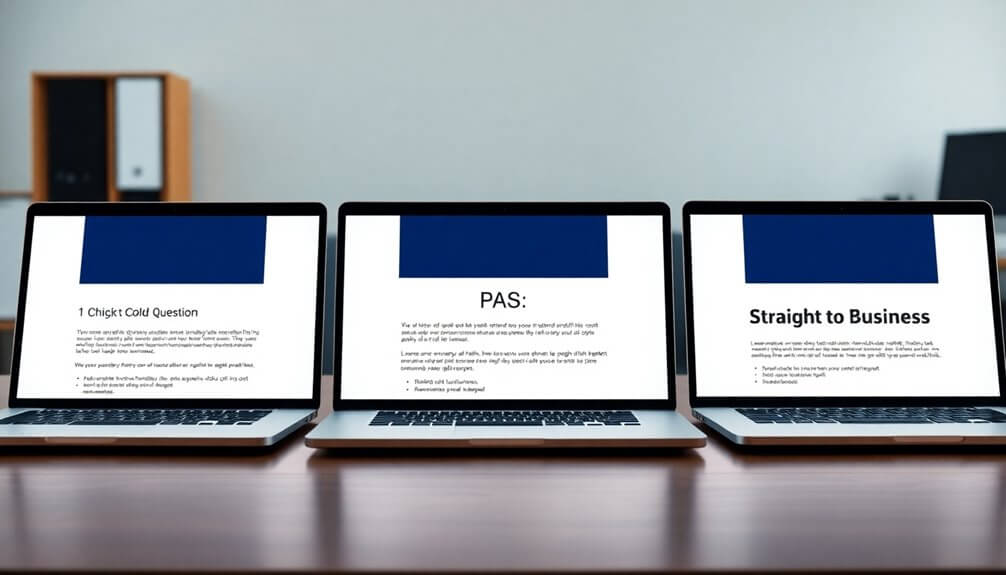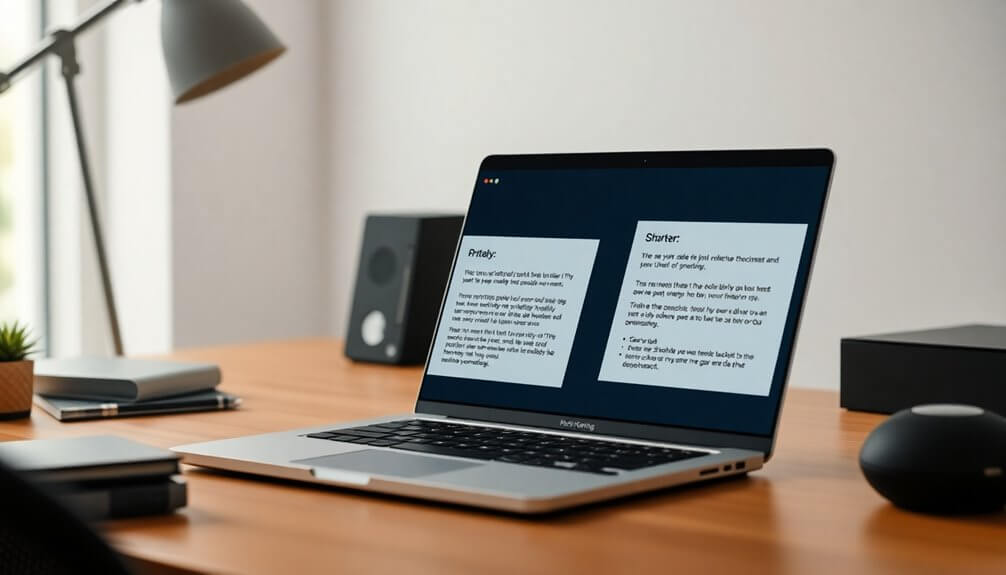You’re about to enter the world of cold emailing, a powerful tool for initiating conversations and establishing connections with potential clients. Crafting effective cold emails requires understanding their purpose, key elements such as compelling subject lines and personalized introductions, and the various types of templates tailored to different goals. To get started, you need to grasp how to create an engaging message that resonates with your audience, sparking interest without overwhelming them. What sets successful cold emails apart, and how can you use this knowledge to boost your outreach efforts?
Key Takeaways
- Personalization is key: Tailor your emails by using recipient names and including relevant details about their company or industry to increase engagement.
- Structure is important: Ensure your cold email includes a compelling subject line, personalized introduction, clear body, direct call-to-action, and professional signature.
- Brevity enhances engagement: Keep your email body concise, ideally between 50-150 words, and use short, simple sentences to make the message clear and engaging.
- Strong subject lines matter: Use recipient names, reference shared interests, and create a sense of urgency to increase open rates and encourage action.
- Clear call-to-action is essential: Make your CTAs direct, concise, and urgent, guiding recipients toward the desired action and highlighting the benefits of your offer.
Understanding Cold Email Purpose
Cold emailing is a proactive outreach strategy that involves sending unsolicited messages to recipients without prior contact or interaction.
When you engage in cold emailing, your primary goal is to initiate a genuine business conversation or introduce a product/service to potential clients. You aim to build relationships with potential customers and generate leads through targeted, personalized messages.
Your cold email goals might include starting a business discussion with a specific individual, introducing a new product or service, generating new leads for business growth, requesting a meeting to discuss business opportunities, or establishing a connection for future business collaborations.
To achieve these goals, focus on personalization by using recipient names and including relevant details about their company or industry. Mention recent company news, industry trends, or challenges to show you’ve done your research.
Include a simple and direct call to action to encourage recipient engagement. High email deliverability is essential to ensure your emails reach the primary inbox instead of being marked as spam Email Deliverability. Effective cold emailing often requires limiting your daily email volume and verifying recipient emails to avoid spam filtersDaily Volume Limit. By following these strategies, you can effectively convert cold leads into business opportunities and expand your business networking efforts.
To further optimize your cold emailing strategy, consider that the cold email purpose can vary widely, and 89% of marketers are currently leveraging email as their primary method of generating new leads.
Key Elements of Cold Emails

To create effective cold emails, you need to master the key elements that make them compelling.
Start by crafting a strong introduction that grabs the recipient’s attention with a personalized opening line and focuses on their needs. Utilizing AI-driven platforms like AI Customization API can enhance personalization, making emails more engaging and likely to resonate with recipients. A well-structured email includes a solid subject line critical first checkpoint, which is crucial for making the prospect want to open the email. Each component of a cold email, including the subject line, introduction, body, call to action, and signature, must work together seamlessly to achieve a high response rate 5 key components.
Effective Subject Lines
Effective Subject Lines (Key Elements of Cold Emails)
When crafting subject lines, use recipient names for a personal touch, reference shared interests to establish connections, and tailor messages to interests or needs.
Pose compelling questions to stimulate curiosity, and create a sense of urgency to prompt action.
Avoid overly promotional language and test and refine subject lines to understand what works best for your audience.
Examples include: “Let’s talk about [topic/idea]!”, “A [better/smarter/faster] way to [reach a specific goal]”, and “Solutions for [Recent Industry Challenge]”.
Cold emails propose an agreement that will be mutually beneficial to the sender and receiver, aiming to establish a relationship with a prospect mutual benefit principle.
Personalized subject lines significantly enhance open rates, as they are 50% more likely to be opened increased open rates. The average open rate for cold emails is notably higher than in general email marketing, standing at 44% cold email open rate.
Body Structure Essentials**
Crafting an effective cold email body structure is crucial for capturing the recipient’s attention and prompting action. When crafting your email body, keep brevity in mind – aim for 50-150 words to increase response rates. Use short, simple sentences to make your message clear and engaging. Personalization is essential for making the message special to the recipient, as it shows that the sender has done their homework and deliberately chose to contact the recipientprospect research. Guarantee the body remains focused on the recipient’s needs and interests, offering a clear benefit or solution to their problem. Additionally, incorporating a strong call-to-action (CTA) clear call-to-action is essential for prompting the recipient to take the next step.
Utilizing specific email templates, such as The Authentic Referral Cold Email and The Authority-Building Referral Emailreferral email templates, can help craft a compelling message tailored to specific needs, such as finding the right point of contact or establishing credibility.
| Element | Description | Example |
|---|---|---|
| Brevity | Keep it concise | 50-150 words |
| Simplicity | Use short sentences | Clear and direct |
| Personalization | Include relevant details | Tailor to recipient |
| Value Proposition | Offer a clear benefit | Solve recipient’s problem |
| Focus | Keep it on recipient’s needs | Avoid self-promotion
Crafting Effective Templates
Effective cold email templates are built around a core structure that captures attention, delivers value, and fosters personal connection.
To craft effective templates, you need to understand the essential components that make an email compelling.
This includes a clear and concise structure featuring an intro, email body, call-to-action (CTA), and signature[3,4].
Personalization plays a vital role in grabbing attention and building trust.
Begin your email with a personalized introduction that mentions a mutual connection or relevant information about the prospect[2,3,5].
Researching your prospects to identify the right decision-maker and tailoring your email accordingly can greatly enhance response rates.
Key to an effective template is clearly explaining what’s in it for the recipient.
Use formulas like PAS (Problem, Agitate, Solve) or AIDA (Attention, Interest, Desire, Action) to provide a compelling value proposition and specific benefits achieved by similar companies or customers[1,4].
Include a clear and low-commitment CTA to increase the likelihood of a response.
Cold emails typically have lower response rates than other forms of communication, but they require less effort on the salesperson’s side and offer scalabilityGroup 1.
Using established cold email templates can improve open rates, with some such as the “quick question” template achieving a 70-80% open rate, which highlights the importance of effective subject lines.
Subject Line Strategies

Subject line strategies are crucial in determining whether your cold email gets opened or lands in the trash.
To increase the chances of success, consider employing several tactics.
Start with Mutual Connection:
Use shared experiences or mutual contacts to break the ice.
For example, mentioning a conference you both attended or a recommendation from a mutual acquaintance can provide a strong basis for engagement.
This tactic can make your email stand out and foster a sense of familiarity. Incorporating a mutual connection, such as referencing a recent event Shared Experiences, can further enhance the effect.
Personalize Your Greetings:
Tailor your messages to individual recipients by incorporating their names and specific company needs.
This helps in creating a sense of relevance and importance.
For instance, a personalized greeting such as “Hi {{Prospect’s_name}}, don’t you know about ?” can stimulate interest.
Create Urgency and Add Value:
Use time-sensitive offers to prompt immediate action.
Highlight competitive advantages or create a sense of scarcity to make your email compelling.
Additionally, emphasize specific benefits and provide unique solutions to add value.
For example, “Get 20+ hours of extra selling time” or “A better way to reach a specific goal” can motivate recipients to open the email.
Effective subject lines are typically under 50 words: Keeping subject lines brief helps prevent truncation, particularly on mobile devices, which is where 80% of users read their emailsMobile Usage.
Body Content Essentials

To craft effective body content in your cold emails, start by clearly stating your value proposition and addressing the recipient’s pain points.
You need to keep the body short, straightforward, and engaging to reduce friction while using clear and straightforward language to highlight the benefits of your offer. Connecting the subject line with the opening line of your email enhances cohesion and prompts the recipient to read further, emphasizing the importance of subject line alignment.
Crafting the Message
Effective email optimization involves maintaining clarity and conciseness throughout. Keep your sentences short and focused, ensuring that your message is easy to understand and skimmable. This approach helps maintain the recipient’s interest and encourages a response. Moreover, including a clear call-to-action with a compelling offer is crucial to maximize response rates, especially considering that cold emailing has a relatively low engagement ratio. Personalization plays a key role in successful cold emails, allowing you to tailor the message to specific prospects and enhance the likelihood of a positive response.
Value Proposition Key
Crafting a compelling value proposition is vital in cold email outreach, as it directly addresses the prospect’s needs and pain points, making your message more relatable and engaging. To develop a strong value proposition, you need to focus on highlighting the benefits your product or service offers, rather than just listing its features.
Your value statement should be concise, clear, and tailored to your prospect’s specific needs. It’s essential to quantify the benefits by using specific numbers or data points to demonstrate concrete results. Emphasize how your solution solves a particular challenge and focus on one key benefit to avoid overwhelming the reader.
Incorporating social proof, such as positive results from past customers, can also enhance the credibility of your value proposition.
In proposition development, it’s crucial to use clear and concise language, avoiding generic terms and vague promises. Instead, personalize the message by referencing specific outcomes and demonstrating relevance to the prospect’s needs.
This approach ensures your value proposition resonates with the reader, making your cold email more effective. By following these principles, you can create a compelling value proposition that drives engagement and conversion.
Moreover, effective cold email campaigns require careful crafting to ensure they resonate with the target audience, which is crucial for achieving high response rates and conversions.
A well-crafted value proposition cold email template typically includes core components like a compelling subject line, an opening paragraph, a section outlining prospects’ needs, an explanation of the product or service, and proof points.
Effective Call to Action**
Your cold email’s success hinges on its ability to persuade recipients to take a specific action, and that’s precisely where a compelling call to action (CTA) comes into play.
Effective CTAs are clear, direct, and concise, guiding the recipient toward the desired action without confusion.
Key elements for crafting effective CTAs include:
- Clear and Direct: Verify your CTA is easy to understand and straightforward to avoid ambiguity.
- Brevity and Urgency: Keep your CTAs brief and create a sense of urgency by including deadlines or dates to promote immediate action.
- Single Action: Limit your email to one CTA to prevent decision paralysis and focus the recipient on the primary action. Emails with only 1 CTA are proven to perform 371% better.
- Testing: Test different formats and placements to find what works best for your audience and refine your CTAs based on feedback.
Crafting effective CTAs also involves understanding their broader role in cold email campaigns, where building a relationship and offering value is key to successful communication.
Additionally, focusing on CTAs with minimal risk and maximum reward can significantly encourage prospective clients to engage with your message, as these types of CTAs reduce the barrier to entry.
Types of Cold Email Templates

Cold email templates are versatile tools tailored to engage potential clients across various scenarios. These templates are designed to address specific needs and offer solutions, leveraging techniques like the Before-After-Bridge (BAB) formula to navigate from a current problem to a resolved future.
The Before-After-Bridge (BAB) Template describes a current situation, imagines it improved, and offers a solution. It focuses on a specific pain point, explains the benefits of solving the problem, and provides a tangible solution or guide while highlighting the sender’s expertise.
Cold Sales Email Templates are another common type, initiating contact by addressing a pain point and offering a solution.
These templates identify industry relevance, mention specific pain points, offer free resources like guides, and include a call to action (CTA) for further discussion.
Additionally, there are specialized templates, such as the Mutual Connection Template for leveraging shared acquaintances, the Cold Prospecting Email Template for introducing new products or services, and the Event Cold Email Template for inviting recipients to relevant events.
Each type is tailored to a specific objective, ensuring that your email marketing efforts are targeted and effective, with a template design that matches your goal. Effective research and personalization are key to increasing open and response rates, making these elements integral to any successful cold email strategy. Statistics show that personalizing cold emails, particularly by using the recipient’s name and referencing their specific challenges, can significantly boost response rates Personalization. High-quality research on recipients’ pain points and needs is essential for crafting relevant and engaging content, thus emphasizing the importance of Recipient Research.
Personalization Techniques

Personalization in cold emails goes beyond basic customizations like using a recipient’s first name, although this simple approach can boost open rates by up to 23% and increase clicks by up to 32%[1, 4]. Effective personalization requires a deep understanding of the recipient’s needs and interests.
It’s not just about using a first name in the subject line. The goal is to create personalized messages that resonate with each recipient.
To achieve this, consider the following strategies:
- Tailor Your Messages: Research and tailor your emails to specific needs or pain points. Different levels of personalization can be used, ranging from basic to advanced techniques that may include referencing recent projects or embedded custom content custom content integration.
- Use Dynamic Content: Customize the email body with custom attachments or references to the recipient’s company or role.
- Mention Recent Achievements: Reference recent company news or industry trends to show relevance and initiative.
- Customize CTAs: Create call-to-actions based on the prospect’s position and needs to boost conversion rates.
Increased personalization can lead to higher reply rates and engagement, often resulting in a significant increase in conversion rates.
Follow-Up and Testing Strategies

Following up on cold emails requires a delicate balance between persistence and respect for the recipient’s time. You need to wait at least 2 to 3 days before sending the first follow-up email, and then space subsequent follow-ups by 2-7 days to avoid overwhelming recipients. An example sequence could be sending the first follow-up after 2 days, the second after 4 days, and the third after 7 days.
This strategy can increase response rates from 9% to 13% with just one follow-up. To optimize your follow-ups, keep them shorter than the initial email and add new value with additional insights or resources. Use clear and personalized call-to-actions (CTAs), such as a link to a scheduling tool like Calendly.
Certify follow-ups are mobile-friendly and keep the overall structure concise with 2-3 short paragraphs. Incorporating testing strategies is also essential. Use A/B testing to compare different versions of cold emails to evaluate effectiveness. Test for generating responses, conversions, and achieving desired outcomes.
Split testing involves comparing two versions by splitting traffic between them, while multivariate testing evaluates the combined impacts of various changes. Continuously iterate on tests to optimize results.
Frequently Asked Questions
How Often Should I Send Cold Emails to My Prospects?
You should send cold emails to your prospects at a consistent weekly frequency, adjusting based on their engagement levels and industry norms. Follow up emails should be sent at ideal timings, typically 2-4 days apart, to maximize reply rates.
What Are the Best Days and Times to Send Cold Emails?
Ironically, you might think sending cold emails at any time is effective, but research shows otherwise. To boost open rates, adopt an email timing send strategy: send between 4:00 AM – 8:00 AM, ideally on Tuesdays and Thursdays.
How Do I Know if My Cold Emails Are Being Flagged as Spam?
To determine if your cold emails are being flagged as spam, check email headers for X-Spam-Status and X-Spam-Level headers and adjust your content to avoid common spam triggers; also, guarantee proper email authentication is set up.
Can I Use Cold Emails for Non-Sales Purposes Like Networking?
Like a key unfastening doors, cold emails can be a powerful tool for building relationships and professional connections beyond sales. By personalizing your messages and following legal guidelines, you can use cold emails to network, seek advice, or share knowledge.
What Legal Considerations Must I Follow When Sending Cold Emails?
When sending cold emails, you must follow legal considerations like the CAN-SPAM Act, ensuring email compliance through accurate subject lines, transparent sender information, clear opt-out options, and adherence to data protection guidelines to avoid penalties.
Conclusion
Mastering cold email templates is like stitching together a patchwork quilt—one misstep can unravel the entire fabric. To weave a compelling narrative, personalize your emails by referencing specific achievements or data points, and thread them with a clear call-to-action. By leveraging the right mix of subject line strategies, body content essentials, and follow-up techniques, you can convert potential leads into valuable business relationships. Craft your emails with precision, and they’ll become the threads that connect you to new opportunities.



